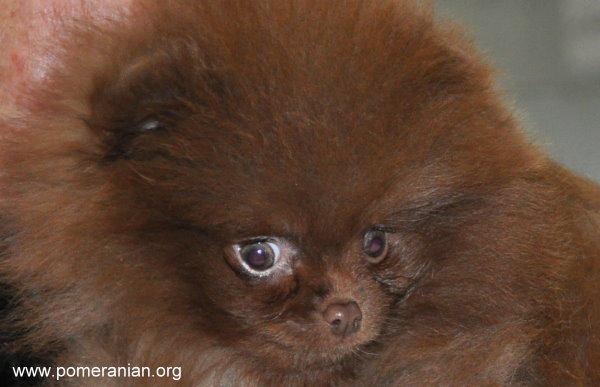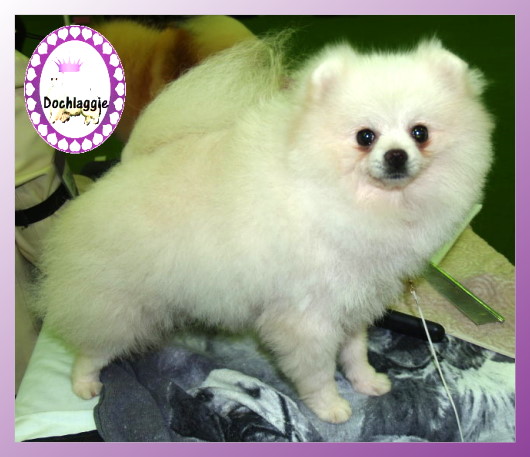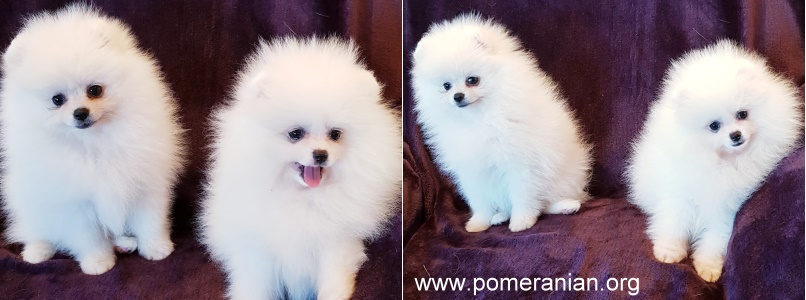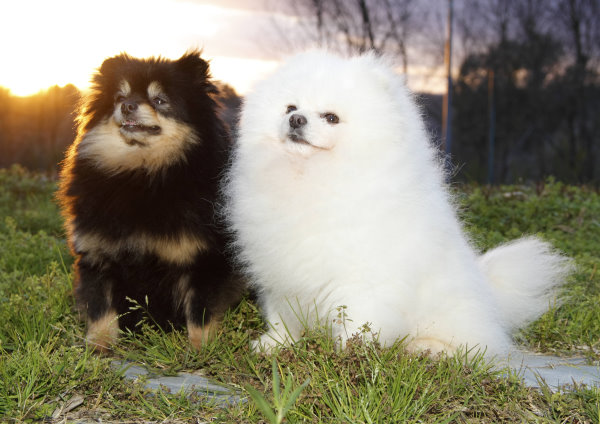
Dochlaggie chocolate Pomeranian Puppy
I would like to share some of the observations made from my personal experience breeding Pomeranians for colour. Hopefully, these observations are of interest to Pomeranian breeders interested in the challenge of breeding and showing colored Pomeranians.
Recently there appears to be more interest in the colored Pomeranians. This renewed attention to the Pomeranian colours other than orange and orange sable can only be beneficial to not only the colored Pomeranians but will undoubtedly benefit the Pomeranian Breed in general.
Over many decades as a Champion Pomeranian breeder, I have produced a rainbow of color in the Pomeranian dogs, including orange Pomeranians, orange sable Pomeranians, beaver Pomeranians, white Pomeranians, cream Pomeranians, wolf sable Pomeranians, cream sable Pomeranians, parti-color Pomeranians, black and tan poms, and black Pomeranians.
Pomeranians colored other than orange or orange sable are frequently referred to as exotic colored. The original Pomeranians colors happened to be the actual colors we currently refer to as exotic colors. Imagine the huge excitement the appearance of the first orange and orange sable Pomeranians caused amongst Pomeranian fanciers of that time. Orange and Orange Sable Pomeranians quickly completely overshadowed the original colors to become the most popular colored Pomeranians.

White Pomeranian
Although the clear orange Pomeranians seem to be the easiest to win with, I have observed many disadvantages to the practice of breeding clear orange Pomeranians to clear orange or orange sable Pomeranians. This practice may result in a softer coat texture than is required by the standard, coat color may appear faded and lack depth and the pigmentation often fades.
Even if your only interest is in producing Orange Pomeranians, using some of the “exotic” colored Pomeranians in your breeding program occasionally can only be an advantage to your oranges. Adding a Black or Black and Tan Pomeranian to the Orange and Orange sables will improve pigmentation and often produces wonderful deep orange Pomeranians with coats of amazing texture, depth, and clarity.
The beaver Pomeranians born at Dochlaggie have been a silvery blue color at birth and upon maturity have wonderful beige coats with self-colored points.
Our whites are a result of breeding wolf sable to wolf sable with interestingly enough, white Pomeranians 11 generations back in the pedigree. I originally purchased the partis to use with the whites but have decided against going down this path. White Pomeranians bred from parti colors, will always be a parti Pomeranian even if you cannot see the parti patches as they are so small and the dog looks to be white in appearance.
Once the parti gene is in the white Pomeranians I may not be able to remove it and I have observed that the parti gene does not always display itself as expected. Most of the Dochlaggie cream Pomeranians start life as sables and by the time they have their adult coat have faded to a beautiful cream color. It is very hard to predict the finished color of the puppy until at least 7 months of age.
We do occasionally produce the cream pomeranian puppy which is born a cream and stays its birth color. A “true cream sable” may appear to be a very light orange sable as a baby puppy. As the coat changes from puppy to adult coat this Pomeranian will be cream with black tips. The cream color may vary from a darker cream to nearly white as an adult Pomeranian.
Both the cream sable and wolf sable pomeranian must have no orange at all in the adult coat. Pigmentation in the cream sable and wolf sable is very black and appears to be very dominant. These are the 2 most useful colors to use as an outcross color in a white breeding program.
Great care must be taken trimming any of the sables for the show ring. So much beauty can easily be lost if the color in the coat tips is heavily trimmed. At birth, to an inexperienced eye, the wolf sable Pomeranian puppies appear to be black, with the telltale silver coming through around the eyes after a few days.

White Pomeranian pups
The Wolf sable Pomeranian appears to be a very controversial subject. If you are unsure of the color of a “true wolf sable” have a look for pictures of a keeshond. The” true” wolf sable Pomeranian should, in color be a miniature version of his larger cousin the keeshond. The wolf sable Pomeranian has the same coloration as a keeshond but I can find no reference in our standard to the wolf sable Pomeranian requiring a black mask. All of my wolf sables are of “keeshond” coloring without the black mask. The best coated Pomeranians are the wolf sables.
The coat texture on a wolf sable will be the harshest and most stand-off you will find. This color in Pomeranians is very rare. I have been given opinions on the wolf sable Pomeranian from people who have never seen one, nor had experience owning and breeding this delightful Pomeranian Color.
Keep an open mind about all the Pomeranian dog colors and if possible travel to see all the colors that our delightful breed comes in. We must all make allowances for the differences in our color monitors, colors on the Internet can really only be taken as a guide and if possible try to personally view as many dogs as possible.
Blacks and the Black and Tans are very useful colors to use in an orange breeding program to enhance pigment and colour depth. Currently here in Australia, Black and Tans are causing controversy regarding the acceptability of this colour.

Black and Tan Pomeranian and white Pomeranian
Black and Tan is one of the original colours in the Pomeranian breed and was included in the list of Pomeranian colors in the Pomeranian breed standard of 1898. The Colors of the Pomeranians as per the Breed Standard of 1898 included- White, Black, Blue, Brown, Black and Tan, Fawn, Sable, Red, and Parti Colors. There have been various changes over the years until we have the current Pomeranian Standard.
For complete and detailed Pomeranian information, Pomeranian Colors and Patterns, How to choose the right Pomeranian puppy for your family, Feeding your new Pomeranian puppy, toilet and crate training your Pomeranian, Socializing your Pomeranian Puppy, Common Health Issues Affecting Poms, Choosing Your Pomeranian’s Veterinarian. The Pomeranian colors explained, Breeding & Exhibiting Pomeranians Download the Pomeranian Book by Pomeranian Breed Authority Denise Leo.
Copyright Pomeranian.Com.Au. All rights reserved.
References and Further Reading:
[1] Denise Leo “The Pomeranian Handbook”.
